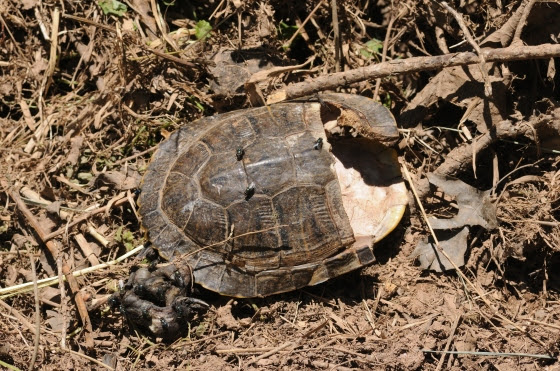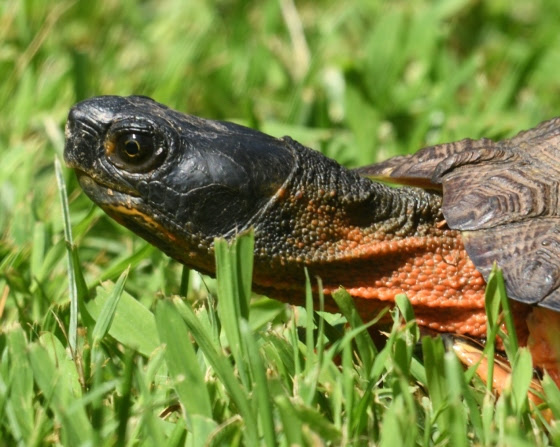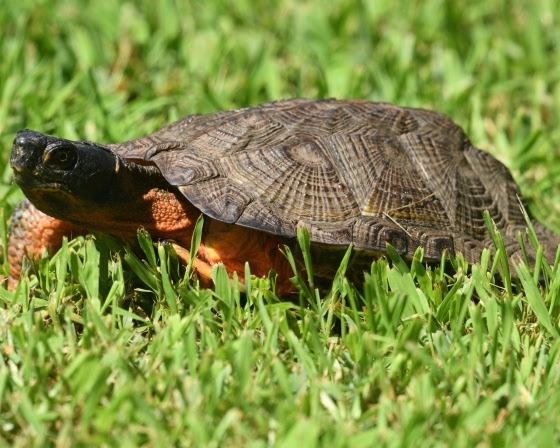Mower May I
Article and photos by Joe Mish
A children’s game, now fading from collective memory, where an authority figure stood facing away from the players who would ask permission to take steps forward. The question included the refrain, “Mother, may I”. The reply might be, ‘take one giant step forward’ or ‘take two baby steps back’. This game is said to be inspiration for Neil Armstrong’s walk on the moon, when he said, ‘One small step for man. One giant step for mankind’.
The months of May and June are the time turtle step forward, one small step for that turtle and a giant step for preserving that species genetic future as they seek a location to lay eggs.
Turtle species have relied on thousands of years of evolution to reach a relatively stable set of behaviors that has seen them through a millennium of environmental change before the appearance of humans.
If change occurs faster than a species can adapt, it ceases to exist. The changes turtles face today were never included in the genetic mapping that made them so successful for thousands of years. Roads and highways, farming and land development have thrown a curve ball to confound the turtles’ evolutionary success via gradual change. Mower blades spinning at 3,500 revolutions per minute sound a death knell to the species in general and elimination of threatened and endangered reptiles from an already shrinking home range.
The presence of a turtle, no matter the species, is a miracle to behold when you consider it is a time traveler, unchanged in appearance from prehistoric times, who stepped through a wormhole in space into the 21st century.
The most common species found crossing roads, as evidenced by unsuccessful attempts, is the ubiquitous snapping turtle. An aquatic species whose genetic GPS directs it to favorable high ground away from the vagaries of floods and droughts to lay its eggs. Perhaps it is the distance traveled to lay eggs that has made the snapper so successful and vulnerable to predators, among them autos.
Another turtle commonly found crossing roads is the eastern box turtle. Box turtles are often concentrated in upland areas. A terrestrial species, it follows the rule of not laying eggs in the area it normally lives. I speculate that predators know where to find their prey and the prey know that the best chance for eggs to reach term would be somewhere away from the general population. So it is that each spring, female turtles will leave home grounds for a suitable nursery in which to incubate their eggs. Eastern box turtles are assigned a ‘concerned’ classification, given a shrinking environment and loss of genetic variation due to populations isolated on islands of habitat. Continuity of habitat is a critical concern and a prime reason to establish and preserve greenways along rivers and streams.
The wood turtle is classified as endangered by state and ‘under review” by federal US Fish and Wildlife Service and is found locally. Aquatic and terrestrial, it spends time in meadows and uplands near rivers and streams making it more vulnerable to mowing not only during spring egg laying but throughout the season from April to October. Wood turtles are long lived and do not reach reproductive age for several years. This makes wood turtle populations very sensitive to loss of any mature adults. Research finds the loss of one or two adults may mark the end of that population over time. From the Wisconsin DNR website “Wood turtle populations are particularly sensitive to removal of reproducing adults, and Compton (1999) determined that removal of only two adults annually from a group of 100 individuals would result in extinction of that population in 76 years, and removal of three adult individuals annually would lead to extinction in 50 years.”
The meadows and uplands along our rivers are prime wood turtle habitat and any mowing must be evaluated for benefit vs harm. Walking trails trod by hikers is preferable to mowing. A mature wood turtle was killed on open space land when a path was mowed for the convenience of some local walkers. This act may have signed a death warrant for the wood turtle population in the area. In this game of survival, the wood turtle may ask ‘Mower, may I ?” when traversing our meadows during egg laying and feeding.
Check these websites, one from Wisconsin and one from New Jersey for more information about Wood Turtles,
and most interesting, the electronic tracking of a female wood turtle at the Great Swamp National Refuge by the US Fish and Wildlife Service!.
https://www.fws.gov/media/wood-turtle-transmitter-colin-osbornusfwsjpg


Author Joe Mish has been running wild in New Jersey since childhood when he found ways to escape his mother’s watchful eyes. He continues to trek the swamps, rivers and thickets seeking to share, with the residents and visitors, all of the state’s natural beauty hidden within full view. To read more of his writing and view more of his gorgeous photographs visit Winter Bear Rising, his wordpress blog. Joe’s series “Nature on the Raritan, Hidden in Plain View” runs monthly as part of the LRWP “Voices of the Watershed” series. Writing and photos used with permission from the author. Contact jjmish57@msn.com.

